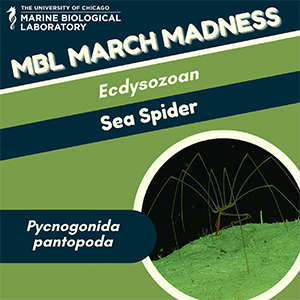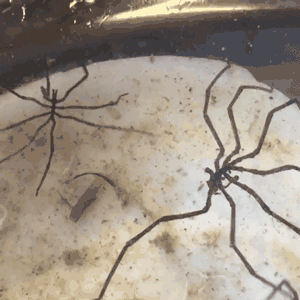MBL March Madness: Sea Spider


Part of in the order Pantopoda, which means “all legs,” sea spiders are also known as pantopods. Although they are a member of the arthropod class that includes horseshoe crabs, terrestrial spiders, and terrestrial scorpions, they’re not really “spiders.” Sea spiders are the oldest members of the Chelicerata and their legs have eight segments, which is the ancestral state of the arthropod leg. The possession of this ancestral eight-segmented leg puts them in an interesting place to study the leg evolution of all arthropods and understanding the processes evolution took to form different kinds of arthropod legs. These marine arthropods can be seen in the waters off Woods Hole but are found from the Caribbean to the polar seas. Longtime MBL Trustee and Nobel Prize winner Thomas Hunt Morgan wrote his thesis on the phylogeny of sea spiders—research he conducted at the MBL from 1889-1890.
Cool facts
- There are more than 600 known living species and at least one fossil species from the Jurassic Period (about 136 to 190 million years ago.)
- During fertilization, male sea spiders take the eggs from the females and carry the eggs on their abdomen until they’re ready to hatch
- They hatch out as a protonymphon, or as “just a head,” similar to a crustacean’s larval stage.
(ID Card Photo Credit: Scott C. France, Wikimedia Commons, Creative Commons)
More about sea spiders and the MBL
Thomas Hunt Morgan at the Marine Biological Laboratory: Naturalist and Experimentalist | Genetics
Select Publications
Cole, L.J. (1901) Notes on the habits of pycnogonids. Biological Bulletin (Woods Hole, Marine Biology Laboratory) 2(5):195-207.
"Biological lectures delivered at the Marine Biological Laboratory of Wood's Holl in the summer session of 1890," hdl.handle.net/1912/21929
Morgan, T.H. (1891) Contribution to the embryology and phylogeny of the Pycnogonids, A Dissertation. doi.org/10.5962/bhl.title.8208
Division: Ecdysozoa
Ecdysozoans are the largest group within the animal kingdom and comprises arthropods (insects, spiders, and crustaceans), as well as nematodes such as roundworms. All organisms in the Ecdysozoan superphylum have an exoskeleton and shed or molt that cuticle layer in order to grow. Learn more about Ecdysozoans here.
Meet the Other Ecdysozoan Organisms
-
- Beach Hopper (Parhyale hawaiensis)
- American Lobster (Homarus americanus)
- Atlantic Horseshoe Crab (Limulus polyphemus)
What is MBL March Madness?
Based on the March Madness NCAA basketball tournament, during MBL March Madness, popular MBL organisms face off for your votes. YOU have the opportunity to decide what organism is crowned victorious by voting for your favorite organisms in a series of head-to-head match-ups. Voting will take place on the MBL social media channels from March 29 - April 7.
